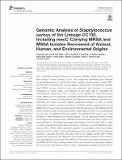Por favor, use este identificador para citar o enlazar a este item:
http://hdl.handle.net/10261/259496COMPARTIR / EXPORTAR:
 SHARE SHARE
 CORE
BASE CORE
BASE
|
|
| Visualizar otros formatos: MARC | Dublin Core | RDF | ORE | MODS | METS | DIDL | DATACITE | |

| Título: | Genomic analysis of Staphylococcus aureus of the lineage CC130, including mecC-carrying MRSA and MSSA isolates recovered of animal, human, and environmental origins |
Autor: | Gómez, Paula; Ruiz-Ripa, Laura; Fernández-Fernández, Rosa; Gharsa, Haythem; Ben Slama, Karim; Höfle, Ursula CSIC ORCID; Zarazaga, Myriam; Holmes, Mark A.; Torres, Carmen | Fecha de publicación: | 2021 | Editor: | Frontiers Media | Citación: | Frontiers in Microbiology 12: 655994 (2021) | Resumen: | Most methicillin resistant Staphylococcus aureus (MRSA) isolates harboring mecC gene belong to clonal complex CC130. This lineage has traditionally been regarded as animal-associated as it lacks the human specific immune evasion cluster (IEC), and has been recovered from a broad range of animal hosts. Nevertheless, sporadic mecC-MRSA human infections have been reported, with evidence of zoonotic transmission in some cases. The objective of this study was to investigate the whole-genome sequences of 18 S. aureus CC130 isolates [13 methicillin-resistant (mecC-MRSA) and five methicillin-susceptible (MSSA)] from different sequences types, obtained from a variety of host species and origins (human, livestock, wild birds and mammals, and water), and from different geographic locations, in order to identify characteristic markers and genomic features. Antibiotic resistance genes found among MRSA-CC130 were those associated with the SSCmecXI element. Most MRSA-CC130 strains carried a similar virulence gene profile. Additionally, six MRSA-CC130 possessed scn-sak and one MSSA-ST130 had lukMF’. The MSSA-ST700 strains were most divergent in their resistance and virulence genes. The pan-genome analysis showed that 29 genes were present solely in MRSA-CC130 (associated with SCCmecXI) and 21 among MSSA-CC130 isolates (associated with phages). The SCCmecXI, PBP3, GdpP, and AcrB were identical at the amino acid level in all strains, but some differences were found in PBP1, PBP2, PBP4, and YjbH proteins. An examination of the host markers showed that the 3’ region of the bacteriophage φ3 was nearly identical to the reference sequence. Truncated hlb gene was also found in scn-negative strains (two of them carrying sak-type gene). The dtlB gene of wild rabbit isolates included novel mutations. The vwbp gene was found in the three MSSA-ST700 strains from small ruminants and in one MSSA-ST130 from a red deer; these strains also carried a scn-type gene, different from the human and equine variants. Finally, a phylogenetic analysis showed that the three MSSA-ST700 strains and the two MSSA-ST130 strains cluster separately from the remaining MRSA-CC130 strains with the etD2 gene as marker for the main lineage. The presence of the human IEC cluster in some mecC-MRSA-CC130 strains suggests that these isolates may have had a human origin. | Versión del editor: | https://doi.org/10.3389/fmicb.2021.655994 | URI: | http://hdl.handle.net/10261/259496 | DOI: | 10.3389/fmicb.2021.655994 | E-ISSN: | 1664-302X |
| Aparece en las colecciones: | (IREC) Artículos |
Ficheros en este ítem:
| Fichero | Descripción | Tamaño | Formato | |
|---|---|---|---|---|
| genomiorigin.pdf | 488,15 kB | Adobe PDF |  Visualizar/Abrir |
CORE Recommender
PubMed Central
Citations
6
checked on 27-mar-2024
SCOPUSTM
Citations
12
checked on 25-abr-2024
WEB OF SCIENCETM
Citations
11
checked on 23-feb-2024
Page view(s)
32
checked on 01-may-2024
Download(s)
79
checked on 01-may-2024
Google ScholarTM
Check
Altmetric
Altmetric
Artículos relacionados:
NOTA: Los ítems de Digital.CSIC están protegidos por copyright, con todos los derechos reservados, a menos que se indique lo contrario.
